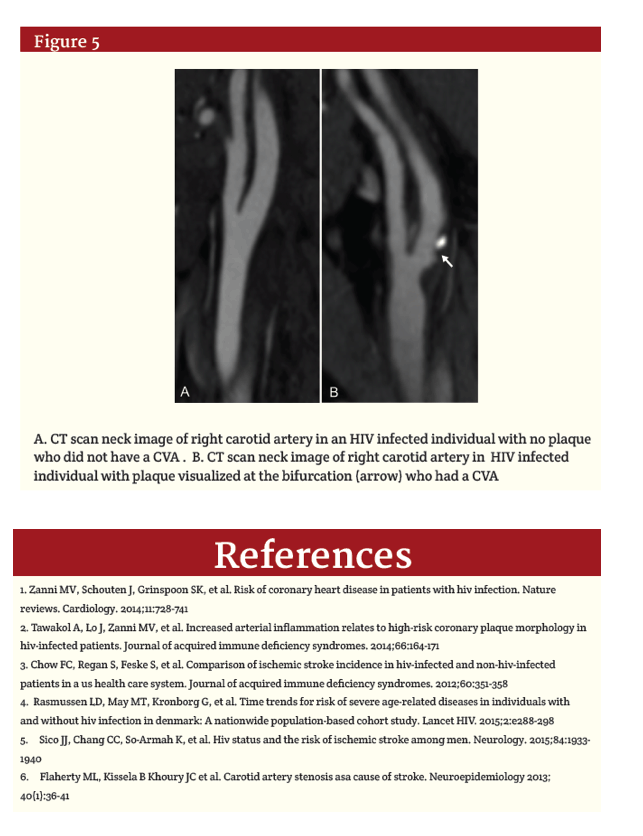 |
 |
 |
| |
Incidental Carotid Plaque in HIV and an increase in subsequent Cerebrovascular Events.....Carotid Plaque Develops More Often With HIV and Triples Stroke Risk
|
| |
| |
Conference on Retroviruses and Opportunistic Infections (CROI), February 22-25, 2016, Boston

Mark Mascolini
WEBCAST:http://www.croiwebcasts.org/console/player/29637?mediaType=audio&
Carotid plaque and noncalcified carotid plaque developed more often in HIV-positive people than in matched HIV-negative controls in a 3-year 341-person comparison in Boston [1]. Both types of plaque approximately tripled the risk of stroke or transient ischemic attack (TIA) in this population with no history of cardiovascular disease.
Previous research found higher incidence of coronary plaque in HIV-positive people, and plaque predicted later coronary events [2]. Much other research documents higher risk of cerebrovascular disease (stroke or TIA) in people with HIV than in the general population. To see if newly developing carotid plaque predicts stroke or TIA, researchers at Massachusetts General Hospital conducted this study.
This retrospective analysis involved all HIV-positive people who had neck computed tomography (CT) from 2005 through 2014 at Partners institutions in the Boston area. Independent teams blinded to study goals collected data and analyzed images for presence and type of plaque. The researchers identified HIV-negative controls who had carotid CTs and got matched to the HIV group by age, gender, reason for CT, and prevalence of diabetes, hypertension, hyperlipidemia, and smoking.
The study included 182 people with HIV and 159 matched controls, none with a history of cardiovascular or cerebrovascular disease. The HIV group averaged 35 years in age and 50 (27%) were women. Prevalence of key conditions was 9% for diabetes, 19% for hypertension, and 11% for hyperlipidemia. Total cholesterol averaged 169 mg/dL, low-density lipoprotein cholesterol 91 mg/dL, and triglycerides 135 mg/dL. Fewer than 15% of cases and controls were taking aspirin, ACE inhibitors, beta blockers, or statins. Median HIV infection duration stood at 15 years (range 9 to 19); CD4 nadir averaged 177 and current CD4 count 364. While 93% of people with HIV were taking antiretroviral therapy, 55% had an undetectable viral load.
Compared with controls, people with HIV had higher incidence of any carotid plaque (30% versus 13%, P < 0.001) or dangerous noncalcified plaque (47% versus 25%, P < 0.02). High-risk plaques (13% versus 5%, P < 0.002) and risky low-attenuation plaques (13% versus 5%, P = 0.02) were significantly more frequent in the HIV group. The groups did not differ in rates of mild or moderate stenosis, which were low.
Among people with HIV, factors that favored plaque development were hypertension (16% versus 13% without plaque, P = 0.004), statin use (16% versus 4%, P = 0.01), and aspirin use (4% versus 2%, P = 0.06).
Through a median follow-up of 3 years, 7 cerebrovascular events occurred in the HIV group (4%), while none developed in matched controls (P < 0.02). In people with HIV, an analysis adjusted for number of cardiovascular risk factors determined that any carotid plaque more than tripled the risk of stroke or TIA (adjusted hazard ratio [aHR] 3.5, 95% confidence interval [CI] 1.6 to 8, P = 0.002), while noncalcified plaque nearly tripled the risk (aHR 2.7, 95% CI 1.3 to 6, P = 0.01).
The researchers concluded that HIV-positive people with no known cardiovascular disease have markedly higher rates of carotid plaque than matched people without HIV, and both plaque types boost the risk of stroke or TIA.
References
1. Janjua S, Staziaki P, Takx R, et al. Incidental carotid plaque in HIV is associated with subsequent cerebrovascular events. Conference on Retroviruses and Opportunistic Infections (CROI), February 22-25, 2016, Boston. Abstract 640.
2. Zanni MV, Schouten J, Grinspoon SK, et al. Risk of coronary heart disease in patients with HIV infection. Nature reviews. Cardiology. 2014;11:728-741.
------------
Reported by Jules Levin
Incidental Carotid Plaque in HIV and an increase in
subsequent Cerebrovascular Events
Sumbal A. Janjua1, Pedro V. Staziaki1, Richard A.P. Takx1, Hamed Emami1, Thomas Mayrhofer1, Orla Hennessy1, Michael T. Lu1, Steven K. Grinspoon3, Markella V. Zanni3, Udo Hoffmann1, Tomas G. Neilan1,2
1Cardiac MR/PET/CT program; 2. Division of Cardiology; 3. Program in Nutritional Metabolism. Massachusetts General Hospital, Harvard Medical School, Boston MA

Over a median follow-up of 3.1 yrs, 28 events occurred in HIV-infected individuals, rate of 4%/yr, as compared to 1%/yr in uninfected controls (P=0.013). Within HIV, the presence of carotid plaque (adjusted HR: 3.5, 1.5-8, P=0.002) and NCP (adjusted HR: 2.7, 1.3-5.8, P=0.01) were associated with an increased risk of subsequent CV events.
Reported by Jules Levin
Incidental Carotid Plaque in HIV and an increase in subsequent Cerebrovascular Events
Sumbal A. Janjua1, Pedro V. Staziaki1, Richard A.P. Takx1, Hamed Emami1, Thomas Mayrhofer1, Orla Hennessy1, Michael T. Lu1, Steven K. Grinspoon3, Markella V. Zanni3, Udo Hoffmann1, Tomas G. Neilan1,2
1. Cardiac MR/PET/CT program; 2. Division of Cardiology; 3. Program in Nutritional Metabolism. Massachusetts General Hospital, Harvard Medical School, Boston MA






|
| |
|
 |
 |
|
|